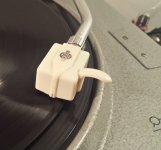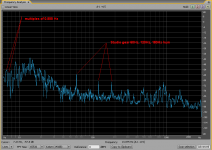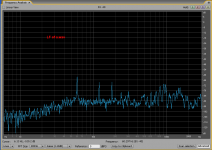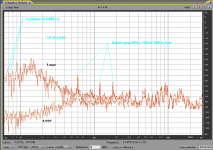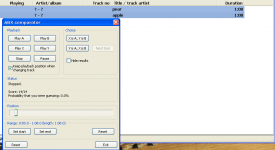Do I like 1inv.wav better because I'm on headphones?
I do not think so. I assume that most of listeners have been using headphones. The difference is well audible with speakers as well. Headphones magnify technical issues.
It's good enough to show the low-frequency differences in these files.True CD vs. vinyl rip:
(P.S.: Audacity is still not the best tool for the reason of limited possibilities of spectrum window setting)
I often use Cool Edit 2000 (my registered version from back then) to play files, so I "see" waveforms even before I play the music. I saw an extra signal in the "quiet" channel at the start of one file, so I zoomed in and saw the low-frequency movement around 10Hz, the tell-tale sign of the compliance-tonearm resonance. You don't need to go to the FFT to see that. That's what prompted my first post in the thread.
As a note, this could have been high-passed filtered at 20 to 40Hz without affecting the music and gotten rid of this 10Hz signal. It helps playback, and it makes it one less way to distinguish LP from tape or CD.
I've read (and subsequently noticed) that some CDs have a spike at 15.75kHz. Older American engineers should recognize this as the US TV horizontal scan rate. This signal is caused by a running TV or CCTV monitor somewhere in the studio, getting picked up either acoustically or electrically.Interesting. That is a very different presentation of it and yet still showing the LF noise.
In Audacity I also noticed the two spikes at 60 and 120Hz but was surprised they were present on both versions. I thought anything like that would have been on the phono stage only. Seems to be on the master though.
There's quite a bit of subsonic noise in the vinyl, around 10-11 Hz - and it peaks at less than 20dB down - presumably the usual TT artifacts. I wonder how much of a difference this would make in some people's systems, because that signal is constantly modulating at least part of the chain?
...
Cantilever and tonearm form two conical pendulums connected by cantilever suspension. Mass of tonearm, cartridge, and counterweight bob about tonearm pivot. Every little motion of stylus pumps the tonearm. This is aggravated by tonearm resonance. Tiny offset of LP center hole and snugness of fit to platter spindle pump the tonearm with every revolution of the platter.
IMHO it's not EVERY little motion, it's just the ones near 10Hz, slight bumps in the LP that move the stylus/cartridge up and down near that frequency.
This happens more at higher volume, and especially in a vented woofer where there's no damping for infrasonic signals and it can easily push a woofer cone near its limits, and certainly into its (more) nonlinear region.Modulation of all the sub sonic garbage with audio band is part of vinyl sound. Result is similar to intermodulation distortion of speaker driver.
When woofer, full range speaker, or headphones are driven with such signals IMD happens.
Regarding Audacity, there's an organised way to put up your hand and ask for more things, or for things to be different - Feature Requests - Audacity Wiki.
I often use Cool Edit 2000 (my registered version from back then) to play files, so I "see" waveforms even before I play the music. I saw an extra signal in the "quiet" channel at the start of one file, so I zoomed in and saw the low-frequency movement around 10Hz, the tell-tale sign of the compliance-tonearm resonance. You don't need to go to the FFT to see that.
We all can see it when playing through Cool Edit or similar SW.
The "extra signal" you are referring to contains 0.555 Hz multiples (frequency of 33 1/3 rpm turntable speed), LF groove noise and electronic hum of poor PSR of the studio equipment at 60, 120 and 180 Hz.
LF of a.wav added for a comparison - see those 60Hz lines.
Attachments
Last edited:
Just for laughs
Perhaps someone could make one
3D Printed Record
Due you have test vinyl with pure tone? 10 or 20 seconds with big FFT or sampled down may show IMD side bands.
Perhaps someone could make one
3D Printed Record
May be 2 sets of files are needed in a blind test like this.
The second set is where the music is band-passed, say 40Hz-10kHz. This will remove the extreme signals where peculiarities exist, and remove non-ears judgement.
I agree, you may try samples of the same files BW limited to 40Hz - 12kHz
https://www.dropbox.com/s/3597rrcy2xi7bnl/pearapple.zip?dl=0
----------------
foo_abx 1.3.4 report
foobar2000 v1.1.6
2015/06/09 09:21:09
File A: C:\Documents and Settings\Administrator\Dokumenty\Hudba\Beatles\pear.wav
File B: C:\Documents and Settings\Administrator\Dokumenty\Hudba\Beatles\apple.wav
09:21:09 : Test started.
09:21:25 : 01/01 50.0%
09:21:35 : 02/02 25.0%
09:21:44 : 03/03 12.5%
09:21:53 : 04/04 6.3%
09:22:01 : 05/05 3.1%
09:22:13 : 06/06 1.6%
09:22:22 : 07/07 0.8%
09:22:31 : 08/08 0.4%
09:22:40 : 09/09 0.2%
09:22:51 : 10/10 0.1%
09:23:00 : 11/11 0.0%
09:23:10 : 12/12 0.0%
09:23:21 : 13/13 0.0%
09:23:35 : 14/14 0.0%
09:25:39 : Test finished.
----------
Total: 14/14 (0.0%)
Attachments
Last edited:
I agree, you may try samples of the same files BW limited to 40Hz - 12kHz
----------
Total: 14/14 (0.0%)
Questions then:
(1) In your case (depends on what you look for in a sound), do you find any possibility that you may change your preference after it is band-passed?
(2) Can band-passing enforces participants to rely more on ears?
Pear is preferred
It is okay if you prefer pear. It is not okay if you say pear is very spicy and a bit bitter.
Questions then:
(1) In your case (depends on what you look for in a sound), do you find any possibility that you may change your preference after it is band-passed?
(2) Can band-passing enforces participants to rely more on ears?
(1) - no, same preference.
(2) - I do not know. The basic distinction is the same. But I listened with Senn HD 598 headphones and floorstanding speakers. Have no idea what happens with notebook speakers or small headphones.
You can see that I have not spoken about technical quality or added noise. Just what is more acceptable and preferred by me in these 2 specific files. I would say that vintage music is to be played on vintage system, it was produced that way to be played on vinyl.
The last comment - I do not like what resulted from 40Hz - 12kHz BW cut, in fact I hate it and I prefer the BW unlimited versions.
Last edited:
I do not like what resulted from 40Hz - 12kHz BW cut, in fact I hate it and I prefer the BW unlimited versions.
Okay, then the method cannot be used. Thanks, Pavel.
...Very huge magnet pickup, excellent kraft, and BIG
Wow! That one oughta make it all the way through "Whole Lotta Love" without even taping a quarter on top!!
I've read (and subsequently noticed) that some CDs have a spike at 15.75kHz. Older American engineers should recognize this as the US TV horizontal scan rate. This signal is caused by a running TV or CCTV monitor somewhere in the studio, getting picked up either acoustically or electrically.
I remember being surprised, as a younger man with younger ears, to actually hear this on a recording, specifically Rush's A Show of Hands on CD back in '89. I could make it out clearly during the interludes between some songs. And of course nowadays it's easy to also see it, using CoolEdit or whatever. What puzzled me at the time was the source - this is a live album, and as far as I know, none of the band members were using any video monitors onstage. There were some fairly elaborate video projections, by '80s standards at least - maybe in lieu of HD Jumbotrons they had some big honkin' CRT projectors singing away near a microphone somewhere. I dunno. What I do know is, I'm listening to it right now, and I ain't hearing it no more.
-- Jim
P.S. Damn, I still love this album, with or without the flyback noise!
- Status
- This old topic is closed. If you want to reopen this topic, contact a moderator using the "Report Post" button.
- Home
- General Interest
- Everything Else
- Listening test - do you prefer CD or vinyl version

